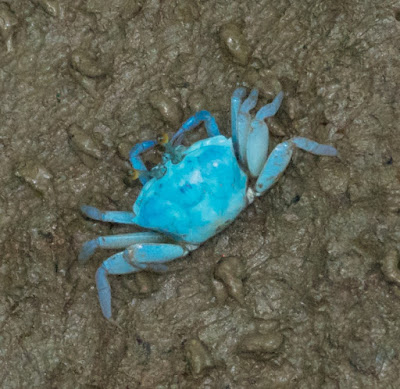Ditches along the trailside were, in effect, fingers of the sea penetrating the forest, home to mudskippers and other animals of ocean mudflats. The upper photo shows two species, the abundant Blue-spotted (Boleophthalmus boddarti) and much larger Giant (Periophthalmodon schlosseri) Mudskipper; below is a closer look at the Blue-spotted.
The contrast between forest and shore, each with its own set of living things, became a theme of our walk.
Plants in the forest understory added dashes of colour, whether from a spray of red berries...
... or the equally-red blossoms of a ginger (Etlingera sp) arising, like the leaves of Nipa Palm, from an underground stem.
Also arising from the forest floor, or at least from rotting, fallen wood: the delicate, ear-shaped fruiting body of a fungus.
A more animated bit of colour: the common and tiny, but always spectacular, Branded Imperial (Eooxylides tharis).
Caterpillars in the forest ranged from the fairly conspicuous (the long hairs on this one suggest that toucching it muight not be a good idea)...
...to the astonishingly well-camouflaged (though this one would have been better off sitting on some nicely-mottled bark than on a green stem).
Other invertebrates on the trail included this rather bandy-legged spider...
... and a tractor millipede (Barydesmus sp) scuttling over the forest floor.
The slick mud of the ditch was crawling with mud creepers (Family Batilariidae), marine snails related to ceriths. They are detritus feeders, and swarm on coastal mudflats.
The mud had its splashes of colour, too, provided not by flowers and butterflies but by an assortment of fiddler and sesarmine crabs.
I believe this is one of the sesarmine crabs, a group rather like fiddlers but lacking the great "fiddle" claws of their males.
These are unmistakably fiddler crabs - notice the enormous claw in the upper photograph. There is a large assortment of fiddler crab species in Sarawak, and I am not sure that I can identify these from photographs alone.
These are (I believe) Blue Fiddler Crabs (Uca tetragonon), a widespread species of the Indian Ocean and the tropical West Pacific and one of the more identifiable of the lot (I think). There were plenty of them skittering over the mud.
This one is keeping close to its burrow, ready to dart into it at any sign of danger.
The burrow might also be handy for escaping the advances of an amorous male.
A careful female keeps her retreat handy as she considers the male's blandishments.
Meanwhile, Blue-spotted mudskippers (Boleophthalmus boddarti) dart back and forth along the shallow channels, their protruding eyes surveying the scene above the water line.
Though mudskippers can spend considerable amounts of time out of the water, they do not have lungs. Nonetheless, they require air to breathe; they will drown if they cannot get it. They can certainly take up oxygen from water with their gills (and, their skins - though to varying degrees among the different mudskipper species -which they constantly moisten in whatever water is available), but their gills are reduced in size and surface area. Instead, the lining of the pharynx (essentially, their throat lining) is thin and loaded with blood vessels, and as long as this is kept moist it can take up oxygen from the air.
That is why mudskippers look so puffy-cheeked as they hop around over the mudflats. Before leaving the water they take up a huge mouthful of water and air, and keep it sealed within their gill chambers as they hop about on land. Their bubbled-out cheeks act a sort of reversed scuba tank that supplies them with air and keeps their gills and their pharyngeal linings moist enough to take up oxygen. This Blue-spotted Mudskipper, obviously, is ready to go exploring.
We, though, are just about done - so before ending this post, here's a look back into the forest, and one of its more spectacular birds, the Asian Fairy Bluebird (Irena puella). This is a female, far duller than the glossy blue-and-back male, but the contrast between the deep red of its irises and the muted blue of its plumage is handsome enough.































No comments:
Post a Comment